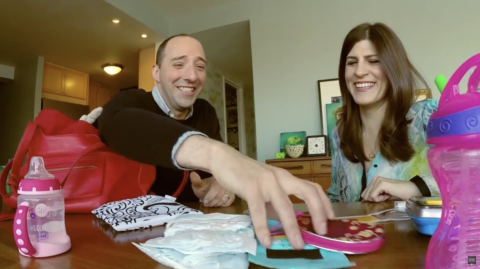
Mazzy has a new game. It’s called “Annoy the Crap Out Of Mom Until She Hands Over The iPad Or Buys Me An Ice Cream Cone”. She’s incredibly good at it. Although, my husband says it’s not the kind of skill I should put on her preschool applications. If that’s the case, I need the behavior to end.
Which brings me to the return of Dr. B.
Remember our early childhood development specialist? She’s here to STOP THE WHINING with some very serious advice. Let’s hope it works.
——————————————-
Young children use whining in the same way that infants use crying – to communicate that they want something and they want it NOW! When children start speaking, we often expect them to use their language to communicate appropriately but talking and communicating are two different skills which typically do not develop at the same rate.
Using language to communicate needs is a learned skill that takes modeling and practice. Most children go through a phase of whining until they learn alternative ways to communicate and begin to recognize that whining is not accepted by those around them.
Some children continue to whine because it works better (or is more powerful) than more appropriate alternatives (i.e., whining leads to the parent listening and/or giving into a request that they initially denied).
For example, picture a child in a candy store who asks politely for a piece of candy and then is told “no.” The child makes the request again, “Please!” The parent stands firm on their initial decision. The child starts to whine and the whine quickly turns into a scream, “I want candy!!!” Finally, out of embarrassment, the parent says, “Which candy do you want?” It is easy to predict what the child will do the next time they want candy or anything else that the parent initially denies.
10 TIPS THAT WILL HELP YOU RESPOND TO WHINING MORE EFFECTIVELY
1) Listen and acknowledge that you have heard your child the first time. Sometimes children are simply trying to get our attention and before we know it, they realize that whining is a quick way to get it.
2) Show you heard your child’s initial request by repeating it (e.g., “You want cookies.”).
3) Do not reward the whining by giving your child anything immediately after whining. This will increase the likelihood that your child will use this behavior again in the future.
4) Teach your child to communicate his/her needs appropriately. For example, for a younger toddler, you can simply stop them from whining by approaching them at eye level and then prompt them to say, “Cookies please” before getting them the desired item. For an older toddler, you may want to teach them to follow a rule such as, “You only need to tell me one time” or to tap your arm or leg to get your attention when you are on the phone or computer. This approach will teach your child the appropriate way to communicate with you while reducing the likelihood that the whining will be maintained by unintentionally rewarding the behavior.
5) Prevent additional whining by talking to your child while they are waiting (e.g., “Wait here. I’m opening the cabinet. Where are the cookies? Oh, here they are!”).
6) If an item is off limits, explain why and then give your child other alternatives to choose from. For example, “You want candy. I liked how you asked me nicely but candy is not good for your belly. Let’s look for some healthy food for you to choose from.” For a younger child, distract them with a favorite toy or activity.
7) If your child’s whining has become a vicious cycle, expect it to get temporarily worse before it gets better when you stop giving in. Although the whining may escalate to a full-blown tantrum (and other worse behaviors) don’t let this fool you into thinking this approach isn’t working. If you give in after ignoring the behavior, you will actually strengthen the behavior and tantrums may become your child’s new “go-to” strategy to get you to give in. Instead, be consistent and stand your ground.
8) Remember that you can respond to your child’s tantrum even if you continue to deny them the thing they want. Some children benefit from having an adult help them calm down, while other children may prefer to be left alone or will react aggressively toward an adult who denied their request. Use your judgment to determine what your child may need in the moment.
9) Don’t expect a quick fix. Stopping a behavior may seem easy but learning new behaviors takes time. Don’t give up because the strategy you were trying didn’t work the first few weeks and don’t stop using a strategy as soon as it starts working. Children learn behaviors best through explicit teaching, repetition, practice, and reminders.
10) Finally, many children are more likely to whine when they are tired, hungry, or not feeling well. If you notice a pattern, be proactive by addressing the underlying problem.
——————————–
Found this post on helpful? Follow Mommy Shorts on facebook!
Editor’s Note: If none of these work, there is one more solution brought to you from our friends in The Netherlands. Although, I’m pretty sure if you are reading this post, it is too late.

























My daughter is the queen of this right now. We’re working hard at teaching her that whining won’t get her what she wants but it’s hard not to cave in sometimes! I’ll have to try out some of these tips.
Thanks!
Ashley
http://www.modernmommymagic.blogspot.com
Urgh whining. The toddler is going through this phase RIGHT. NOW.
It’s good to know I’m on the right track, I don’t give in to the whining, I tell him why he’s not getting his way, then distract him with something else (usually TV – hey, it works). He still whines though so I’m guessing he’s just finding his boundaries. I hope.
We are just getting our whining sea legs. Good God, is he three yet? 😉
Also, I love how in your picture Mazzy has two Boos and two cups and yet she is still unhappy. She is the poster child of how having many things won’t give you eternal happiness 😉
I knew someone would pick up on that. That is her “stuff”. Both Boos, a cup of milk and a cup of water. Lately it also includes Cookie Monster (the big one!!!) and a miniature Ernie figurine that she affectionately has nicknamed “Erns”.
my niece is going through a whiny phase right now…passing these tips on to my sister and hopefully save her sanity.
I am one of those parents who gives in sometimes. I know I have to stop but whining is my kryptonite. They can scream bloody murder, throw things, yell and it won’t phase me. But whining?!?!? Gets me every time 🙁
Also, that commercial is absolutely hilarious! Talk about effective birth control.
Hysterical commercial!
Great ideas, my daughter is in the biggest whining phase ever… ever. EVER.
I also send my daughter in to “change her attitude” go in her room and pretend to change her shirt—it gives us both some break time, and a great distraction
From experience I can tell you these steps work. My DD hardly ever whines unless #10 is in effect. About every 4 weeks or so she tries to test the boundaries though. But I stand firm. On occasion it does spiral into a tantrum. Which brings me to #8. It has always been my problem. I can’t figure out if my staying close helps or harms. Early on (she was adopted at age 2.5) I left her alone, but was conflicted (everything says leaving her alone reinforces abandonment), but I observed it escalated more when I tried to hold or comfort her. And, honestly, I had to be away from her to calm myself sometimes. I was doing time-outs and they stopped working. I do time-ins but still don’t know if I should hold her or not. I read somewhere that even if arching to get away you hold on anyway until they relax, but that doesn’t make sense to me. How can you tell when you should hold or not? How can I help her to calm down before it gets really ugly? Distraction is not working so well with my now almost 4 year old.
Did you resolve it and how? My daughter is the same way and i just don’t know what to do.
I’m totally keeping my husband away from Dr. B.
Because my “whine until I get an iPad or an ice cream cone” plan still works on him.
Usually.
Oh my goodness. That condom commercial is the funniest thing I’ve ever seen. Awesome!
My three-year-old is a whining expert because her big brother has been training her since birth.
I will try to follow these helpful steps. Yes, I will.
I will not just reach for Bunny Gummies or the remote. No, I won’t.
Honestly, it’s adorable. Also? I think I prefer “Erns” to Ernie anyway.
Bwah hahahaha! That commerical is fantastic! LOVE IT!!
I cannot stand the whining. My boys seem to still go through stages of it even at 8 and 5. Standing my ground and sticking with my method of dealing with it seems to make it go away.
Now Buggy, well he is almost 17 months and we’ve hit the “I don’t have the words so I’m just going to scream at you until you give me what I want” phase. Anyone have a good suggestion for earplugs?
Great post!! I just got done reading Happiest Toddler on the Block and these suggestions are very similar. I highly recommend it to all parents of toddlers. 🙂 That being said, we are still a work in progress.
This worked for mine when a tad older (closer to 2.5-3) , when she whined I would hold out my hand and say “Give me your whiney voice please”, then would “put it in my pocket” and say “OK, I have your whiney voice in my pocket now, so try asking again”. Genius or cheesey, it worked for us to nip it in the bud 🙂
I held my oldest and walk away from my youngest because different things worked for them as different kids. Which I understand, my oldest was more sad and needing a hug, my youngest is more mad when tantruming so needing time/space to get over it. Which I get, I mean if you are yelling at your husband and so he sweeps you into a bear hug would it stop the arguement or make you want to throttle him? 😉
Based on that description, I’m totally someone who wants to be held. If I storm out of a room and my husband doesn’t try to follow me, I get even madder!
Just cover the ear altogether and get some noise-canceling Bose headphones. I think think of better earplugs than ones that play your favorite music.
Whatever works- I am going to try it. Mazzy is OBSESSED with pockets these days. Although I don’t think she’s understand the concept of “whiny voice” yet.
My just-turned-two-year-old is in full-on mega whine mode. He doesn’t even attempt to ask for something, he just starts pointing into the kitchen and whining. How the eff am I supposed to interpret that? There are 50 things he could possibly want. I’ll go through a list of his common things and then he’ll just suddenly stop and continue playing. Drives me friggin’ insane. I absolutely hate whining and sometimes I think he’s just messing with me because he knows it.
If she resists being held, let her calm down on her own but stay in close proximity to make sure she’s safe.
It is better for her to calm down on her own if she can but it is also important that she knows you are close by to help and you’re not going to leave or abandon her just because she behaved badly.
If her tantrums escalate to the point where she is in danger of hurting herself or others, holding her until she is calm might be necessary.
Consulting with a psychologist may be helpful if she has tantrums daily or if they often escalate to physical aggression on a consistent basis.
Ha, that is so funny! Because when I leave a room and my husband tries to follow me, it makes me even madder! I need time to process things and calm down on my own. I just found my kids have such different personalities. The eldest was born with an easy-going, happy-go-lucky, obedient personality. Could have been raised with wolves and ended up the same I tell ya. Once when she was (I know, far too young, but wanted to see what would happen) 18 months I put her on a time-out on the stairs – forget why, let’s assume I had good reason and move on shall we? lol! – anyway, I expected her to get up and move on, as it was more to get her away from what she had been doing. The kid sat and sat until I said “um, you can get up now?” and she did. My husband commented how my second one isn’t ever on a time-out on the stairs and I said “Um no. Because when I tried once or twice, she not only immediately threw herself off the step, but started grabbing everything within reach and hurling it across the room!”. So – she goes straight to her room with less hurl-able objects. Sometimes I stay in it, but if she freaks even looking at me, then I leave but am right outside. I either peek on her every so often or she will open the door herself – though then she has been known to see me there and freak out all over again! She just seems to have a quick fuse and a long burn once it is lit – but eventually she calms down and we snuggle it out. She is a firecracker, but it will serve her well in time I am sure. Will never be a follower, that’s for sure! 🙂 And in fairness, it is typical triggers she reacts to as alluded above (tired, hungry, overstimulated, etc.) when I control her environment she is a lot better at controlling her temper.
We are going through this right now with Kyle who has reached the age of being able to let us know he wants something, but not yet learnt any words. The fact that Kiki didn’t really speak until age 3 scares the bejeezus out of me that I may have another 18 months of this…
Great post! At what age can you start using these tips?
So any tips for a parent with a child that still Whitney even tho I have never given in to the whining and I even talk to her and tell her I won’t listen until she use her big girl voice. She is six and it seems like the whining will never end
I see why that was banned
[…] (adsbygoogle = window.adsbygoogle || []).push({}); Read more […]
[…] liked this suggestion from an article I read at Mommy Shorts. This one is more about helping your child understand that you are hearing their request even if […]